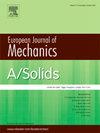对称破缺晶格星形蜂窝的力学行为
IF 4.4
2区 工程技术
Q1 MECHANICS
引用次数: 0
摘要
本文研究了星形蜂窝超材料的面内压缩和弯曲性能,重点研究了传统对称和新型对称破碎设计。通过实验测试和有限元模拟相结合的方法研究了这些超材料在压缩和弯曲载荷下的力学行为。分析了蜂窝结构的应力-应变曲线、变形机制和能量吸收特性,并与提出的单(SSS)和双(DSS)对称破碎模型进行了比较。结果表明,SSS和DSS模型在压缩过程中的比能吸收(SEA)和有效杨氏模量(Ee)方面均优于传统星型设计,在0.5应变下,DSS模型的比能吸收(SEA)高68.8%,SSS模型的比能吸收(SEA)高35.6%。在弯曲荷载下,SSS设计在40 mm挠度下的SEA比传统结构高出约26.8%。此外,该研究还探讨了不同组装机制对压缩性能的影响,包括间隔阵列和手性顶点配置。结果表明,装配方式对超材料的载荷分布和能量吸收有显著影响。在面外压缩下,DSS和SSS蜂窝在0.3应变下的SEA分别提高了19.73%和19.16%。此外,与基准相比,DSS设计在面外弯曲下的SEA提高了21.43%。与基准模型和DSS模型相比,SSS设计,特别是在使用间隔阵列或手性顶点组件时,表现出了卓越的SEA和结构稳定性。这项研究强调了对称破碎蜂窝结构在需要增强机械性能和能量吸收的应用中的潜力。本文章由计算机程序翻译,如有差异,请以英文原文为准。

Mechanical behaviors of star honeycombs with symmetry-broken lattices
This study investigates the in-plane compression and flexural performance of star-shaped honeycomb metamaterials, focusing on conventional symmetric and novel symmetry-broken designs. The mechanical behavior of these metamaterials under compressive and bending loads was examined through a combination of experimental tests and finite element simulations. Stress-strain curves, deformation mechanisms, and energy absorption properties were analyzed to compare the benchmark honeycomb structure with the proposed single (SSS) and double (DSS) symmetry-broken models. Results show that both SSS and DSS models outperform the conventional star design in specific energy absorption (SEA) and effective Young's modulus (Ee) during compression, with DSS exhibiting 68.8 % higher Ee and SSS achieving 35.6 % higher SEA at 0.5 strain. Under flexural loading, the SSS design surpassed the conventional structure by approximately 26.8 % in SEA at 40 mm deflection. Additionally, the study explores the impact of different assembly mechanisms, including interspaced array and chiral vertex configurations, on compressive performance. It was found that assembly patterns significantly affect the load distribution and energy absorption of the metamaterials. Under out-of-plane compression, DSS and SSS honeycombs showed 19.73 % and 19.16 % higher SEA at 0.3 strain, respectively. Furthermore, the DSS design demonstrated 21.43 % greater SEA under out-of-plane bending compared to the benchmark. The SSS design, particularly when using interspaced array or chiral vertex assemblies, demonstrated superior SEA and structural stability compared to the benchmark and DSS models. This research highlights the potential of symmetry-broken honeycomb structures for applications requiring enhanced mechanical performance and energy absorption.
求助全文
通过发布文献求助,成功后即可免费获取论文全文。
去求助
来源期刊
CiteScore
7.00
自引率
7.30%
发文量
275
审稿时长
48 days
期刊介绍:
The European Journal of Mechanics endash; A/Solids continues to publish articles in English in all areas of Solid Mechanics from the physical and mathematical basis to materials engineering, technological applications and methods of modern computational mechanics, both pure and applied research.

 求助内容:
求助内容: 应助结果提醒方式:
应助结果提醒方式:


